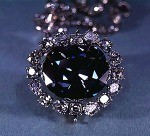Gemstone Cuts and The Why.
Who does the cutting? What are the different methods of cutting? Ever thought why it is cut that way?
What is a cabochon? Why a Marquise? isn’t that a Royal title such as Baron or Earl? ( Actually it is a royal title that is lower than a Duke but higher than an Earl, if you are into Royalty.)
After delving into the history of gemstone cutting I have found some interesting answers.
A gem cutter is called a “Lapidarist” This trade is usually learned on the job, but there are several colleges that do give courses. How long it takes to learn, depends on the skill of the student.
The different methods of cutting are tumbling, cabbing, faceting and carving.
Tumbling, the simplest method, is done in a revolving barrel with abrasives. Finer and finer abrasives are used until the stones have the expected high sheen. This is closest to nature as the same thing happens to stones in a stream. Of course, man made tumbling creates a much higher polish.
Cabbing is the cutting of cabochons, the most common form of gem cutting.
Cabochons are cut with a highly polished rounded or convex top, no faceting,and a flat or slightly domed base. This cut is used for softer stones to safeguard them from scratching. It is also the main cut for opals, turquoise,onyx, moonstone and star sapphire. Cabochons are not actually cut but shaped and polished. they are much easier to produce than faceted stones witch have many angles. They can be produced in any shape but oval is the most used.
This cut is used for star saphires and tiger’s eye stones to get the most of the design and brilliance.
The faceted cut can be various shapes, where as the cabochon has special limits.
Facet is the cut but not the shape. It is actually the shaping of many cuts to show the stone at it’s best color and shine.
All natural stones including the rocks you might find along the edge of the road, have prisms or points of light that enhance their color. ( You might want to study an old rock just for the fun of it.) Faceting was created to take advantage of that fact.
There are simple faceted cuts such as these step cornered aquamarine gems from the Smithsonian gem gallery or the many faceted cuts shown here in this round brilliant cut.
This started in the 13th and 14th centuries. At a time when stone cutting machines were being invented to actually do the job. Before then, one would have to hire an artist to actually carve out a stone by hand, which could take many, many hours. Today there are very few lapidary carvers. One design that has been carved through the ages is the Cameo, which is usually cut from sea shells or agate.
The Marquise Cut
The marquise cut is a thin oblong shape with pointed ends and is named after Jean Antoinette Poisson, the Marquise de Pompadour……….. It is said French King, Louis the IV, asked his jewelers to create a cut to capture his mistress’ smile
… For that interesting story go here..http://www.ajsgem.com/articles/history-marquise-cut.html
A marquise has 57 facets.
Marquise Cut
The Princess Cut
Then there is the Princess cut which is a square version of the round brilliant. It has 76 facets.
With modern computers Lapidarists are creating more and more advanced designs for faceted gemstones.
For a more complete picture go to http://www.e-jewel.co.il/en/gemstonesshapes.aspx?PageID=259 Very interesting.
Now with all the modern computer technology, the Lapidarist can create original cuts never before seen. The Lapidarist artist would start with the anatomy of the gemstone, observing the natural prisms in each piece, just as the stone carver would, then proceed to work his magic.
Note: If you would like to learn more about the “Hope” diamond check out my blog post under diamonds “Famous Diamonds” It has a fascinating history. It even has a curse!
Until next time,
Enjoy your gemstones.
Erma
Resources: Wikipedia, Gemselect, Gem society, as well as many others from around the world.






